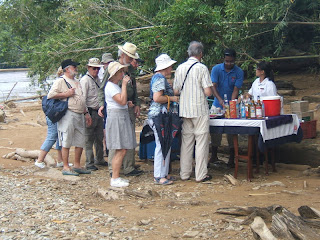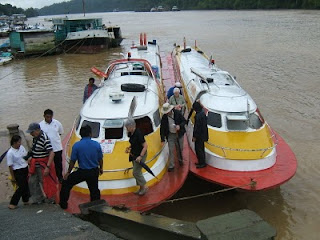I was woken unceremoniously at 4.00 a.m. by two or three fishing vessels returning to port with their raucous marine diesels disturbing the night. Word processing kept me busy for a while, then I just relaxed on the bed until 5.45 a.m. when I had a shower, dressed and went up to the Sun Deck for an early morning cup of tea. The usual early risers were up there.
At some point ‘Pandaw’ had moved from her offshore mooring to a quay. The quay had a large transit shed and an impressive entrance from the road with separate weighbridges for vehicles in and vehicles out together with a large (unstaffed) security office. There was also a large static water tank which I presume was for fire suppression in the transit shed. But the whole facility had been unused for some time and it currently served merely as an easy way to get us ashore. In addition, during the day, the boat took advantage of the good access to take on two road tanker loads of fresh water.
Breakfast started early on Friday at 6.30 a.m. for those people going on the 7.30 a.m. Shore Excursion. This Excursion involved a minibus ride to Longhouse Rumah Nyuka at Bayong followed by a trek to the Sarekei Waterfall and back lasting about two and a half hours. For passengers who didn’t fancy trekking, there was a departure by minibus at 8.30 a.m., stopping at a Pepper Farm and then going on to the Longhouse to meet up with the earlier group.
After breakfast, I prepared for our hike with Factor 30 Sun Block and a Jungle Formula insect spray. A number of minibuses were lined up on the quay for the 7.30 Shore Excursion and as each vehicle was filled, it made its way through the town towards the Longhouse. Sarikei is quite a large place and there were traffic lights and dual carriageways that come as quite a shock after the smaller places we’d stopped at. Almost every shop and business premises we passed had the name repeated in both Malay and Chinese. It was clear that there’s a large Chinese community here and that it’s a relatively prosperous area. There were some very nice detached houses with landscaped, well-groomed gardens. There was also a lot of new housing estates – Sarikei must be a desirable place to settle. Once we turned off the main road, we headed into the hills and the road undulated like a switchback as we approached the Longhouse. It was a pretty uncomfortable ride in the back of the minibus! After about tens minutes of this up and down, we suddenly arrived at our destination.
 Longhouse Rumah Nyuka at Bayong
Longhouse Rumah Nyuka at Bayong
We parked on the concrete road laid outside the Longhouse’s verandah and, once everyone was assembled, we divided into the Waterfall Party provided with two local guides and the Nature Party who intended to hike a shorter distance with Henry explaining some of the local Flora.
The party that set off for the Waterfall was still quite large. We took a track regularly used by residents of the Longhouse to reach their farming land. After a short climb, we entered a shady forest section. The bamboo bridge over the stream at this point had recently been damaged so we were forced to ford the stream, introducing some delay although it was only around six inches deep. We passed a field with a wooden pig sty. The female domesticated boar there had a number of playful (and hungry) babies. Next, we came to a field of pepper plants, each plant trained up a substantial pole. Sarikei is famous for its pepper. The path then ran across a rice paddy on a series of planks arranged to keep your feet dry when the field is flooded. We found one cheerful woman working here.

We carried on along the bank of a stream, shaded by trees, eventually crossing the stream on a bamboo bridge and passing a number of rubber trees. Next, the track ascended a fairly steep hillside covered in pepper plants. In hill planting, the pepper plants are often planted together with a brightly-coloured broadleafed plant whose root system protects the soil from erosion. Having climbed almost to the top of the hill, the path then dived down into the valley where we came to our goal – the waterfall. Not the biggest waterfall I’d seen but very attractive. Once everybody in the party had arrived, it was time to set off back again. On the way back, I found three large centipedes on the path, the largest at least six inches long. There was the usual delay fording the stream and by the time we arrived back at the Longhouse, the party who’d left the ship at 8.30 a.m. had arrived. My pictures taken on the trek are here.
The covered verandah of the Longhouse provided a huge space for communal activities and our arrival appeared to be an excuse for something of a party. Most of the women were congregated in one section with the children, just sitting on the floor and watching, but friendly and quick to smile. Next came a section where handicrafts were laid out for sale. The women on the stalls had pretty good English. Next, was a refreshment station with tea, coffee, juice and very nice crunchy ‘biscuits’ being mass produced in a couple of small woks just behind. Finally, a mat had been laid for dancing and there was the normal ‘band’ of a large gong beating time and the usual instrument with seven gongs to play the melody. There was plenty of seating for the visitors to watch as they had their refreshments. My friend Jim tried the big gong, then I was invited to try. Before I could stop, the melody had started up on my beat and one of the Longhouse men was doing a ceremonial dance, complete with head-dress, so I felt I had to keep going (or should that be 'gonging'?). Eventually, the official ‘gong man’ relieved me. Tim was then invited to dance and was photographed in the head-dress. While the band had a rest, an audio system blasted out a modern tune and six women, all in identical shifts, started the dance I’d seen on the boat – two steps right, two steps left, two steps back, rock for one beat then a quarter turn left. Done properly, it looks very good. A little later, one of the women invited me to join her and I struggled to copy the (simple enough) moves. Longhouse people and my fellow passengers watched me make a fool of myself with interest. When I made a mistake, I would rush to pick up the beat again and this provoked gales of friendly laughter from the Longhouse people. One of the Longhouse men joined in so we had a line of three dancers, two of whom knew what they were doing. It was a marvellous experience and my performance was rewarded with a second cup of tea and more of the ‘biscuits’. Pictures in the Longhouse.
All too soon it was time to clamber back into the mini-bus for the teeth-jarring ride back to the ship. At the very least, the minibuses could do with some new shock absorbers. Pictures on the journey.
Lunch in the dining room was the usual convivial occasion and then there was time to ourselves until a walking tour of Sarikei town at three o’clock. As three o’clock approached, the heavens opened and we had a torrential rain storm. It was probably twenty minutes before the rain had abated sufficiently for us to venture out with umbrellas. Louis and Henry accompanied us, pointing out some of the shops of interest. At the town square, they left us to our own devices with strict instructions to be back on the boat by five o’clock. This gave me time to take a number of photographs around the town and along the waterfront. I bought a cheap printed sarong with a traditional Sarawak design and then spotted a computer shop. My Notebook Computer has developed a keyboard encoder problem meaning that some of the recent posts have been a bit of a pain to write. So I went in the shop and bought an External USB Keyboard which is working fine. I rather liked the idea of buying high-tech computer equipment in Borneo! Needless to say, the keyboard was made in China.
I returned to the boat in good time as preparations were being made for our departure. Just as we were about to depart, a tug appeared from a tributary just upstream towing a log 'raft'. Now, the log 'rafts' they use in Sarawak are not like I've seen in photographs from North American logging. In Sarawak, there is a single cable running the length of the raft and each log is attached to the cable at one end only, herringbone-style. So emerging from a side-river and turning left to pass us and go downstream must be a bit tricky. They'd placed a red flag on the vertical pole near the front and another near the and. This was the only warning to other river traffic! The raft passed us safely and then I realised that one man in a small dinghy with an outboard had been attached to the back end of the raft as it made its turn. I presume he was there to try and tow the back end out of harm's way if there was a problem. However, apparently satisfied that the tow was satisfactory, he detached the dinghy, started the outboard and sped back to the tug. We then set off downstream, passing the tug and log raft further down river as he was not making much speed with such an unwieldy tow.
As it became dark, we turned to face upstream and anchored for the night, somewhere near Kampung Seberang. I went to bed quite early - the combination of the trek and the dancing seemed to have taken its toll. But I was disturbed by the noise of a marine diesel engine, so I slipped on some clothese and went to the Upper Deck to see what was going on. A number of my fellow passengers were still up there drinking and talking. The tug with the log raft was bearing down on us with his headlight blazing on a course set to take him between 'Pandaw' and the nearer bank. It was quite obvious that, whilst the tug would get through, his 'herringbone' load of logs was far too wide. The tug stopped just short of us and a cross voice could be heard shouting in the dark. Our crew must have agreed to re-position the 'Pandaw' and once we had moved further from the bank, the tug, making a deafening noise as the tried to get the raft moving again, moved slowly past us, followed by his load of timber, which now displayed two white lights, one near the front and one near the back. After this excitement, I was able to get to bed.
Postscript 24-Jun-2010
After I'd returned to the UK, I was delighted to hear from Daniel, who produces a blog about Sarikei which you can find here. A section on Sarikei's history is here. There's a growing Facebook Group for Sarikeians here, with links to maps and further information about the town.























